
Ashley Whitlock
Hampshire & IOW Butterflies and Moths
Migratory Butterflies and Moths and butterflies we have lost in Hampshire
This page is currently under construction

Map Butterfly laying her eggs on Nettle on Mt Blanc France
The Map not found in the UK. This striking butterfly exhibits seasonal dimorphism, having two forms, levana and prorsa that represent the spring and summer broods. levana individuals are primarily orange in colour, giving them the appearance of a small fritillary, whereas prorsa individuals look more like a small White Admiral.
The Map was unofficially introduced to the UK in 1912 when the butterfly became established in the Forest of Dean in Monmouthshire and Symond's Yat in Herefordshire. An entomologist at the time, A.B. Farn, was so opposed to the introduction of a foreign species that, in 1914, he collected and destroyed every butterfly he could find. However, the ultimate demise of the colonies is believed to be the result of additional (and unknown) factors.
There have been other records from England, some in recent years that are attributed to be either genuine migrants, accidental imports or releases from captive-bred stock.
Eggs are pale green and laid on top of each other in long strings hanging from leaves of Stinging Nettle (Urticaceae). The caterpillars are black, speckled along the back with pale yellow, and have dark orange multi-branched spikes along the back and sides. The chrysalis is pale brown, marbled and flecked with olive, usually suspended by the cremaster from a stem of the foodplant.
Adults use a wide range of herbaceous plants for nectar while males are known to absorb salts and other nutrients from damp soil.
Size and Family
-
Family: Nymphalids
-
Size: Medium
-
Wing Span Range (male to female): 40-50mm
Conservation Status
-
Butterfly Conservation priority: Low
-
European Status: Not threatened
Caterpillar Foodplants
Caterpillars feed on Stinging Nettle
Habitat
Open deciduous woodlands, riverbanks and on farmland where stinging nettle is abundant.
Distribution
-
Central Europe, extending across temperate Asia to China, Korea and Japan.
-
Distribution Trend Since 1970s: N/A
The Monarch is the largest butterfly seen in the British Isles and is also one of our rarest migrants. Known for its ability to travel large distances, the migrations in North America are one of the greatest natural phenomena in the world - where the adult butterflies can migrate from as far north as Canada to the overwintering grounds in Mexico, the west coast of California and Florida.
Millions of the butterflies make a 2,000-mile (3,220km) journey each year from Canada to pass the winter in central Mexico’s warmer weather. But climate change, pesticides and the incursion of illegal loggers have seen the forests dwindle and with them, the number of monarchs.
First recorded in the UK in 1876.
Size and Family
-
Family: Nymphalids
-
Size: Large
-
Wing Span Range (male to female): 95-100mm
Conservation Status
-
Butterfly Conservation priority: Low
-
European status: Not assessed
Caterpillar Foodplants
Caterpillars feed on various Milkweeds (Asclepias species), a plant which is not native to the British Isles, and this explains why the butterfly has not been recorded to have bred here.
Habitat
A rare migrant to the UK but in their native home of the United States, the butterfly can be found almost anywhere that their foodplant grows, including farmland, gardens and even roadsides. The Monarch overwinters in sheltered forests made up of Eucalyptus trees, Monterey pines and Monterey cypresses.
Distribution
-
Countries: England, Scotland, Ireland and Wales
-
Recorded throughout Britain and Ireland as a very rare immigrant with a concentration of sightings in the south-west, notably from Cornwall and Scilly Isles.
Monarch
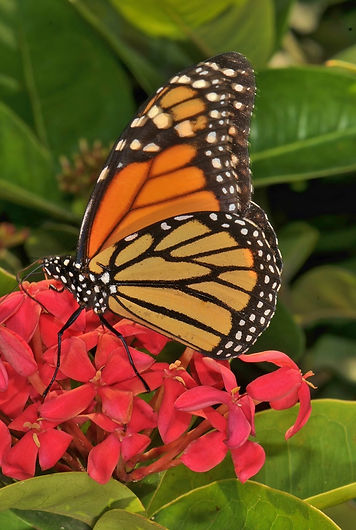

Large Tortoiseshell Copyright © Nikki Kownacki

The Large Tortoiseshell was once widespread across Britain and most common in the woodlands of central and southern England but while its numbers were always known to fluctuate, it declined to extinction by the 1960s. This butterfly has not been recorded from Ireland.
It is still common in some parts of Europe, but declining in others. There continue to be sporadic records in Britain, the majority from the south coast but some are considered to be of specimens released from reared stock rather than genuine immigrants.
There have been several suggested causes for its decline - including climate change, parasitism, and the effect of Dutch Elm disease on one of its primary foodplants.
Size and Family
-
Family: Nymphalids
-
Size: Large
-
Wing Span Range (male to female): 68-75mm
Conservation Status
-
Butterfly Conservation priority: Presumed Extinct
-
European status: Declining
Caterpillar Foodplants
Caterpillars feed primarily on Elms (Ulmus ssp) but can also found on Aspen (Populus tremula), Birch (Betula), Poplars (Populus) and Willows (Salix).
Habitat
Historically in the British Isles, the Large Tortoiseshell inhabited woodland, especially those containing sallows whose flowers provide a primary nectar source for the adults in the spring. It was extremely common in the New Forest in the Victorian times 'especially about woodmans and keepers cottages' Frohawk a famous Lepidopterist in the Victorian times said it was very widespread and common in the Inclosures.
Distribution
-
Countries: England, Wales and Scotland (Presumed Extinct)
-
Previously widespread in England, Wales and Scotland, their strongholds were in the midlands, south and east of England. Recent sightings from the south coast, in particular from Devon, Hampshire, the Isle of Wight and Sussex.
Photograph shows the Large Tortoiseshell maybe still extant on the Isle of Wight but whether this is a naturally occurring specimen remains to be seen. The butterfly over the last few decades has had some sporadic sightings. It was seen at Hook Heath 1991 and again at Titchfield Haven in 1999. Also at Fort Cumberland at Southsea in Portsmouth where it remained for a few days feeding on Bramble. There has been sightings and possible breeding Specimens at Portland in Dorset over the last couple of years.
The Swallowtail this butterfly is present throughout the entire Palearctic region, ranging from Russia to China and Japan, (including the Himalayas and Taiwan), and across into Alaska, Canada, and the United States, and thus, is not restricted to the Old World, despite the common name. In Asia, it is reported as far south as Saudi Arabia, Oman, the high mountains of Yemen, Lebanon, Iran and Israel. In southern Asia, it occurs in Pakistan and Kashmir, northern India (Sikkim, to Assam, and Arunachal Pradesh), Nepal, Bhutan, and northern Myanmar.
This butterfly is widespread in Europe. In the United Kingdom, it is limited to a few areas in the Norfolk Broads of East Anglia. It is the UK's largest resident butterfly. The monarch (Danaus plexippus) is slightly larger, but is only a rare vagrant.
As P. machaon is widespread throughout Eurasia and often common, it is not threatened as a species.[3] It is listed as "vulnerable" in the South Korean and Austrian Red Data Books, and in the Red Data Book of the former Soviet Union. In Armenia the species demonstrates stable population trend and is assessed as Least Concern. [5]
In some countries, P. machaon and its subspecies are protected by law. Papilio machaon machaon is protected by law in six provinces of Austria, Czech Republic, Slovakia, Hungary, Romania, and Moldova. The species is protected in the United Kingdom, and subspecies verityi is protected in India.[3]
Description
The imago typically has yellow wings with black vein markings, and a wingspan of 65–86 millimetres (2.6–3.4 in).[6] The hindwings of both sexes have a pair of protruding tails which give the butterfly its common name from the resemblance to the birds of the same name. Just below each tail is one red and six blue eye spots.[7]
In the caterpillar stage, P. machaon has a length of 45 millimetres (1.8 in). When young, the caterpillar resembles a bird dropping, giving it camouflage. The caterpillar also protects itself using a large orange fork which protrudes behind its head.[7]
It can be distinguished from Papilio hospiton, which occurs sympatrically with it on Corsica and Sardinia, by the longer "tails" on the hindwings.[8] It can be told apart from the Algerian species Papilio saharae only by counting the segments on the antennae.[8]
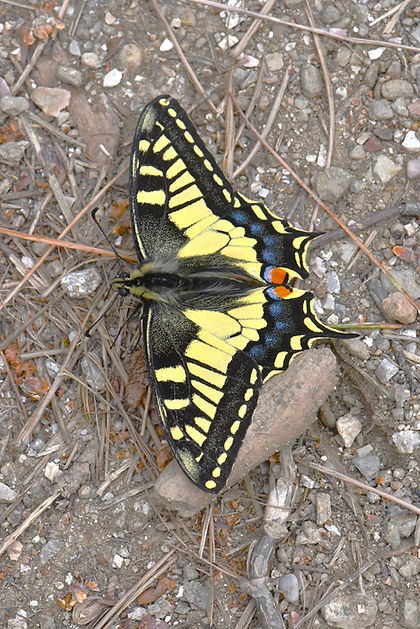
European Swallowtail taken in Montenegro April 2025
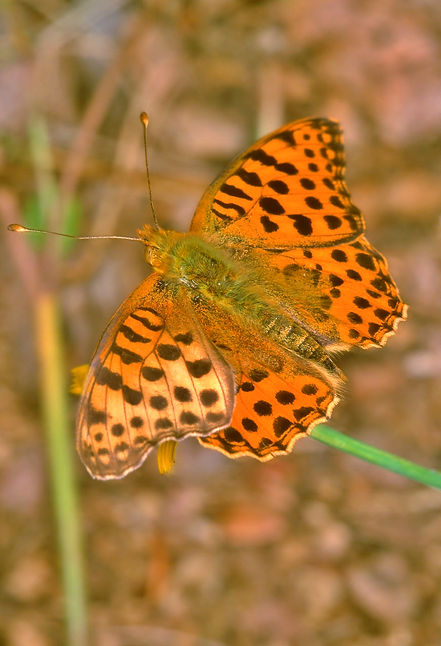
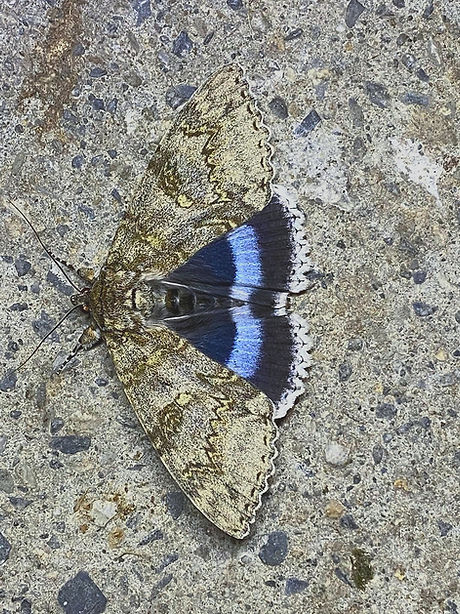
Sometimes referred to as the Blue Underwing, the Clifden Nonpareil is a very large and impressively beautiful and rare moth.
This unmistakable insect is strongly attracted to sugar at dusk and will come to light but can also be seen by day at rest on tree trunks and walls. It has even been recorded flying inland from the sea.
Winter is spent as an egg on the foodplant with the caterpillars hatching the following spring when they can be found through to July, feeding at night. The pupa is made in a silken cocoon that is spun between leaves or among leaf litter.
Flight Season
Flies from late August through to early October in one generation.
Size and Family
-
Family – Erebidae
-
Large Sized
-
Wingspan Range – 75-95mm
Conservation status
-
UK BAP: Not listed
-
Recent colonist, immigrant and former resident
Caterpillar Food Plants
Caterpillars feed mainly on Aspen (Populus), but has been recorded on other poplars in mainland Europe.
Habitat
Can be found in broadleaved woodland but wandering adults can be seen in almost any habitat.
Distribution
-
Countries – England, Wales and Scotland
-
Former resident in Kent and the Norfolk broads in the 1930's and recolonised southern England from 2007. Now resident locally and spreading north in Hampshire, Isle of Wight, South Wiltshire, Dorset, Sussex and Kent. Scarce Immigrant.
The Queen of Spain fritillary is a striking butterfly known for its vibrant colors and distinctive markings, primarily found in Europe and parts of Asia.
Description
Queen of Spain Fritillary
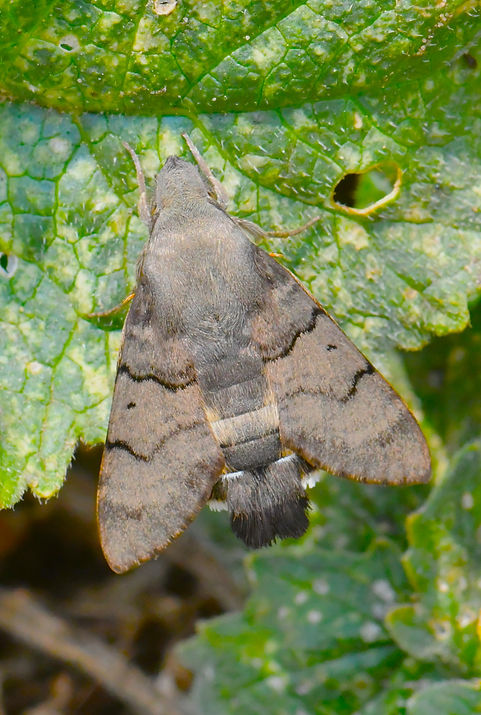
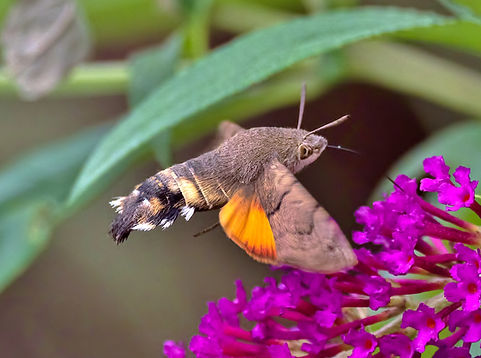
The Hummingbird Hawkmoth is an annual migrant to the British Isles in variable numbers with periodic large influxes depending on favourable migrating conditions.
In strong migratory years they can frequently be seen in gardens and the open countryside as far north as Scotland but are more common in southern regions.
As well as being attracted to a variety of flowers they can often be seen flying around bare rocky outcrops and sea cliffs. Their appearance around such exposed rocky features is a particularly common occurrence in south west Cornwall although the reason for this behaviour seems uncertain.
Despite being mainly diurnal small numbers are also attracted to light at night.
Hummingbird Hawkmoths have a wing span of up to 50mm and are most frequently seen flying during the day when they hover at flower heads to sip nectar.
As their name suggests they resemble diminutive Hummingbirds and are unlikely to be confused with any other moth or butterfly in the British Isles.
When hovering the Hummingbird Hawkmoth is reputed to beat its wings at up to 80 times a second and when doing so reveals orange underwings and black and white patches on the side of the abdomen.
Occasionally they may be found settled on the ground with wings closed where they are easily over looked.
Other common Hawkmoths are The Privet Hawkmoth,
The Eyed Hawkmoth, The Poplar Hawkmoth and The Lime Hawkmoth.
Migrant Hawkmoths include The Death’s-head Hawkmoth, The Convolvulus Hawkmoth, The Striped Hawkmoth and The Oleander Hawkmoth
The Geranium Bronze is a South African species that has been introduced to some parts of Europe. It was first recorded in Britain (in recent times, at least) in 1997. The picure shown was taken in Italy.
Description
The upper wings are bronze brown with a white border, while the undersides of the wings are a complex pattern of white bands and various shades of greyish brown. Males and females are very similar and difficult to separate at a distance. Wingspan ranges from 18 to 23 mm, and there are two short tails. The underwing pattern suggests an eye spot, which may serve as a deterrent to predators.
Habitat
The main larval foodplants of the Geranium Bronze are pelargoniums and geraniums, but in Italy it is reported that they also feed on Mexican Fleabane Erigeron karvinskianus.
Distribution
In Britain the Geranium Bronze is an adventitious butterfly, arriving as either eggs or larvae on imported Pelargonium plants (which most people refer to as 'geraniums'). Their native range is South Africa, but they have been introduced, almost certainly by accident, to many central and eastern European countries.
Etymology
The specific epithet marshalli honours the Indian-born British entomologist Sir Guy Anstruther Knox Marshall (1871 - 1959) who first described this species scientifically in 1897.
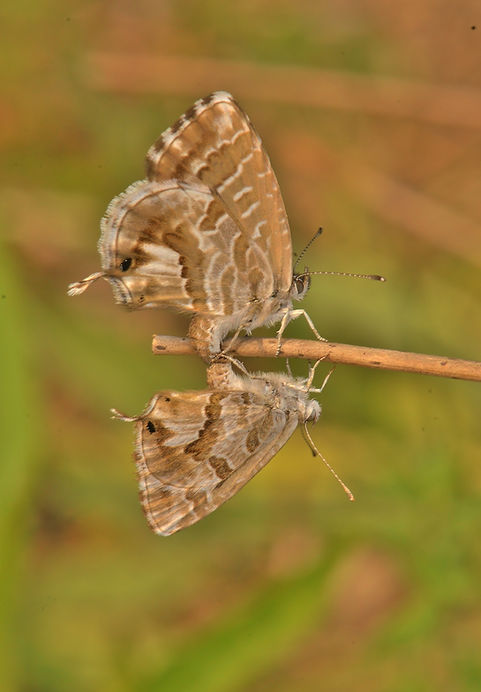
Mating pair of Geranium Bronze
The Long-tailed Blue (Lampides boeticus) is a striking butterfly known for its vibrant colors and unique tail features, primarily found in southern Europe and increasingly seen in the UK due to climate change.
Characteristics
-
Size: The wingspan ranges from 24 to 34 mm, with males being slightly smaller than females.
-
-
Habitat and Distribution
Native Range: The Long-tailed Blue is originally from the Mediterranean region but has a wide distribution, including parts of Africa, Asia, and Australia. It is considered a rare migrant to the British Isles, with most sightings occurring in southern England and the Channel Islands.
-
-
Behavior and Life Cycle
-
-
-
-
Conservation Status
-
In summary, the Long-tailed Blue is a fascinating butterfly that has become more common in the UK due to changing environmental conditions, making it a subject of interest for both enthusiasts and conservationists alike.
-
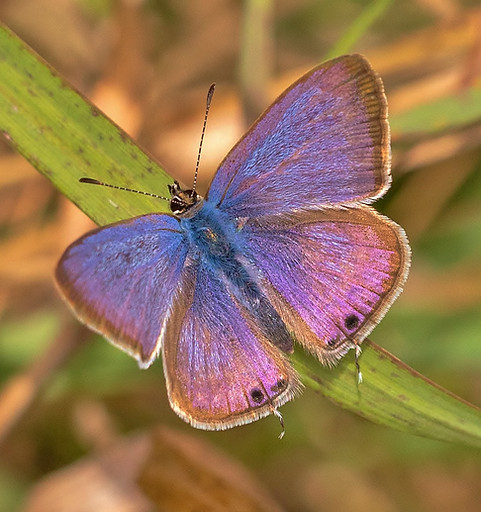
Long-tailed Blue seen up on Portsdown Hill in 2022
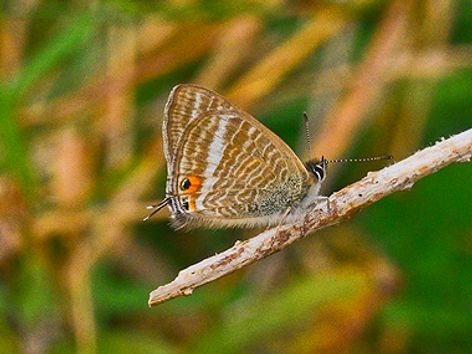
Underneath pattern of the Long Tailed Blue
picture Alan Thornbury
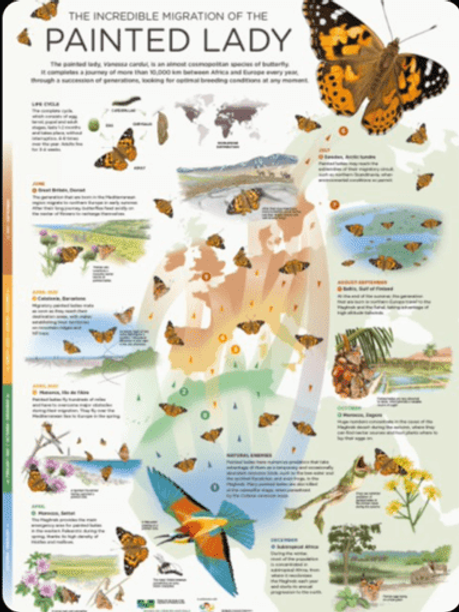

%20July%202015.jpg)
One of the longest standing mysteries of migration has finally been solved after scientists discovered where the UK’s Painted Lady butterfly population goes each autumn.
The butterfly, a common immigrant, migrates from the continent each summer to UK shores in varying numbers. But up until now, scientists did not know if the Painted Lady made the return journey at the end of the summer, like the closely related Red Admiral, or simply died in the UK.
In one of the largest citizen science projects ever conducted, scientists from Butterfly Conservation, the University of York, the NERC Centre for Ecology & Hydrology and Rothamsted Research amongst others, have discovered exactly what happens to Painted Ladies each autumn.
More than 60,000 public sightings of the butterfly during 2009 were collected across Europe including radar images tracking butterfly movements across southern England with 10,000 British observers taking part.
Scientists discovered that the Painted Lady did indeed migrate south each autumn but made this return journey at high altitude out of view of butterfly observers on the ground. Radar records revealed that Painted Ladies fly at an average altitude of over 500 metres on their southbound trip and can clock up speeds of 30 mph by selecting favourable conditions.
The findings also revealed that the species undertakes a phenomenal 9,000 mile round trip from tropical Africa to the Arctic Circle – almost double the length of the famous migrations undertaken by Monarch butterflies in North America.
The whole journey is not undertaken by individual butterflies but is a series of steps by up to six successive generations so Painted Ladies returning to Africa in the autumn are several generations removed from their ancestors who left Africa earlier in the year.
Richard Fox, Surveys Manager at Butterfly Conservation, was one of the report authors. He said: “The extent of the annual journey undertaken by the Painted Lady butterfly is astonishing. This tiny creature weighing less than a gram with a brain the size of a pinhead and no opportunity to learn from older, experienced individuals, undertakes an epic intercontinental migration in order to find plants for its caterpillars to eat.
“Once thought to be blindly led, at the mercy of the wind, into an evolutionary dead-end in the lethal British winter, this amazing combination of mass-participation citizen science and cutting edge technology has shown Painted Ladies to be sophisticated travellers.
“We are extremely grateful to the many thousands of members of the public who reported Painted Lady sightings and contributed to this extraordinary discovery.”
Radar in Hampshire operated by Rothamsted Research revealed that around 11 million high-flying Painted Ladies entered the UK in spring 2009 with 26 million departing in autumn.

Painted Ladies by Jim Asher
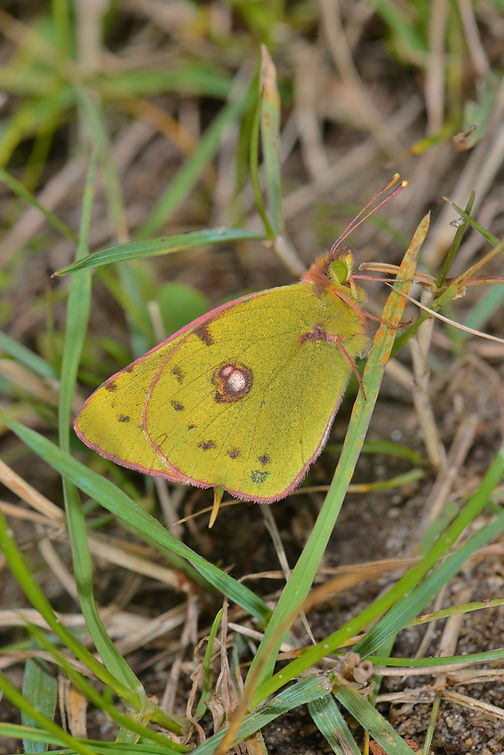

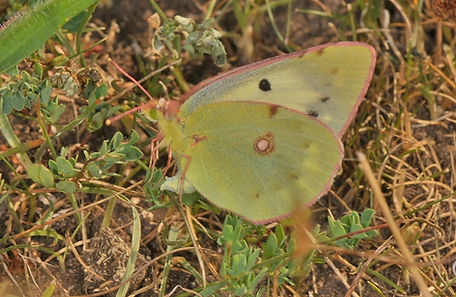
The Clouded Yellow is one of the truly migratory European butterflies and a regular visitor to Britain and Ireland. Although some of these golden-yellow butterflies are seen every year, the species is famous for occasional mass immigrations and subsequent breeding, which are fondly and long remembered as ''Clouded Yellow Years''. A small proportion of females are pale yellow (form helice), pictured above laying eggs they can be confused with the rarer Pale and Berger's Clouded Yellows.
Size and Family
-
Family: Whites and yellows
-
Size: Large
-
Wing Span Range (male to female): 57-62mm
Caterpillar Foodplants
A range of leguminous plants is used, including wild and cultivated clovers (Trifolium spp.), Lucerne (Medicago sativa), and less frequently, Common Bird's-foot-trefoil (Lotus corniculatus).
Lifecycle
Habitat
Clouded Yellows may be seen in any habitat, but congregate in flowery places where the larval foodplants grow. As clovers are still commonly cultivated, the Clouded Yellow is one of the few butterfly species that have no difficulty locating breeding habitat in the modern farmed countryside. In southern England, there is a preference for unimproved chalk downland.
Distribution
-
Countries: England, Ireland, Scotland and Wales
-
Anywhere, but most commonly close to the coast in southern England.
-
Abundance trend: 568% (1979-2019)
-
Distribution trend: -67% (1994-2019)
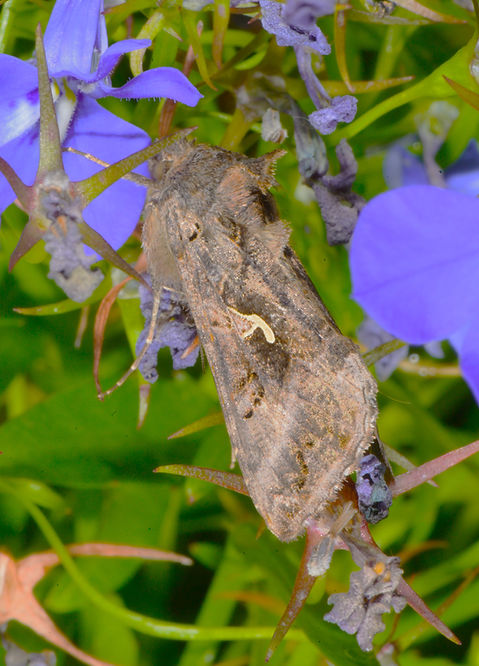
_JPG.jpg)
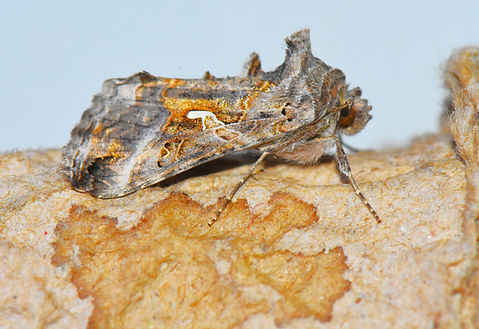
The Silver 'Y' Moth is probably the UK's most common immigrant moth. Each forewing has a conspicuous unbroken metallic silver Y-marking. Could be mistaken for the Ni Moth, which is generally smaller with a broken-Y mark or the Scarce Silver Y which is darker in colour. Superficially similar to several other species, but generally distinctive. F. gammina is smaller and can be found in most years.
Usually most numerous from late summer into autumn, it can occur in any month with those in the winter generally associated with warmer southerly winds.
Medium Sized
-
UK BAP: Not listed
-
A wide range of low-growing plants, including bedstraws (Galium sp.), Clovers (Trifolium sp.), Common Nettle (Urtica dioica), Garden Pea (Pisum sativum) and Cabbage (Brassica oleracea).
Can occur almost anywhere, from coastal habitats to inland sites and can be frequent in gardens. Tends to breed in unshaded situations.
-
Countries – England, Wales, Scotland, Ireland
-
Can occur throughout the UK and breeds here (although the early stages cannot survive the winter), with numbers fluctuating from year to year. Flies by day and night. The swift flying adults are frequently observed nectaring at flowers by day and just before dusk. Also readily disturbed from vegetation by day. In some years it can be especially numerous, particularly near the south or east coast.
One of the most attractive of the Tiger moths, the Jersey Tiger Moth this species was until relatively recently restricted in distribution to the Channel Islands and parts of the south coast .
On the mainland it was commonest in south Devon, but began to spread north and eastwards, and colonies appeared in Dorset and the Isle of Wight and more recently in other southern counties.
It now seems to be expanding its range quite quickly and there are good numbers to be found in London and neighbouring counties. At the time of writing there are records from Bedfordshire, East Anglia and no doubt it will continue to be found in more places; it is a very distinctive species.
It flies both in the daytime, when it can be found feeding on various flowers, as well as at night, when it is attracted to light.
The main flight period is July to September. The hairy larvae feed on a range of herbaceous plants including nettle (Urtica).
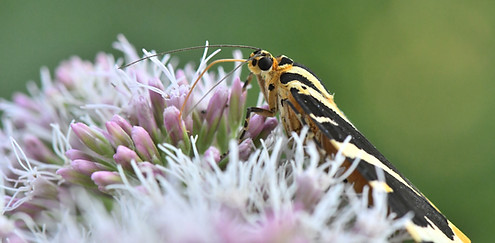
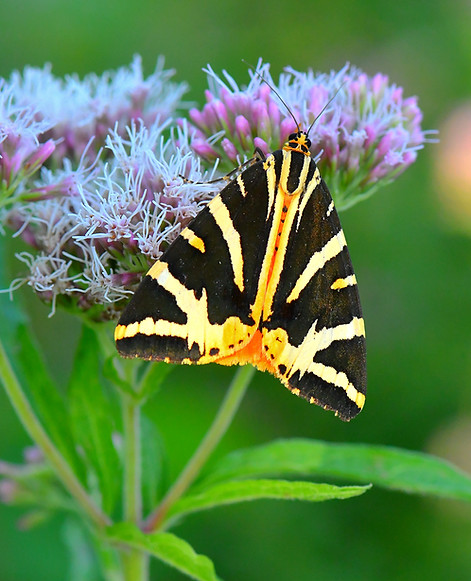
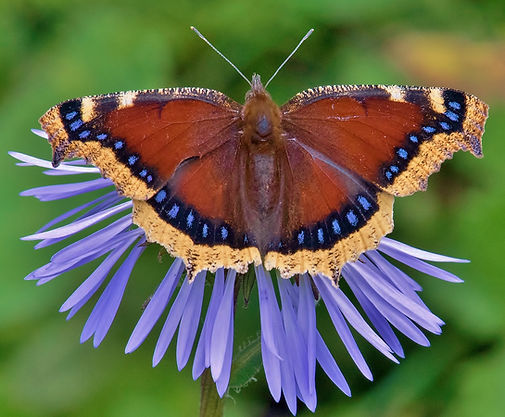
The Camberwell Beauty : This is a large and distinctive butterfly, even in flight, as the white wing borders are unmistakable. The adults live solitary and, as such, migrate singly rather than in the swarms associated with other migrant species.
Migrant insects arrive in Great Britain most years during summer and autumn, but numbers are usually very low. There is no evidence that the species breeds in Britain; it is thought that mild, wet winters prevent them from surviving here for very long. It was believed that some sightings had originated from individuals that had hibernated in stacks of timber which were then shipped to England, and had not travelled naturally.
These butterflies have a lifespan of 11 to 12 months, one of the longest life-spans for any butterfly.
Family: Nymphalids
-
Size: Large
-
Wing Span Range (male to female): 76-88mm
-
Butterfly Conservation priority: Non-native
-
European status: Not Threatened
-
Caterpillars feed primarily on Elms (Ulmus ssp), Poplars (Populus) and Willows (Salix).
-
In Europe and America, the butterfly is found predominantly in cold, mountainous areas but can often be seen in hardwood forests and even gardens where it will feed on rotting fruit.
-
Countries: Commonly found throughout all of North America and most of northern Eurasia, except the UK and Ireland.
-
There have been sightings from many parts of the British Isles but most records are from eastern counties.

Black-Veined White
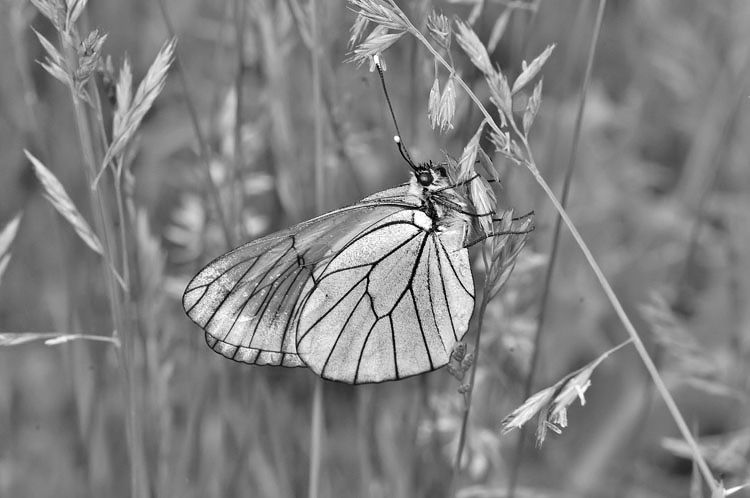
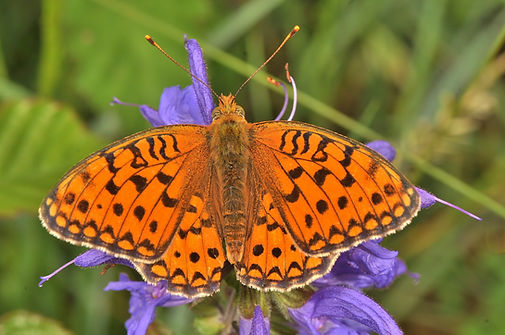
High Brown Fritillary
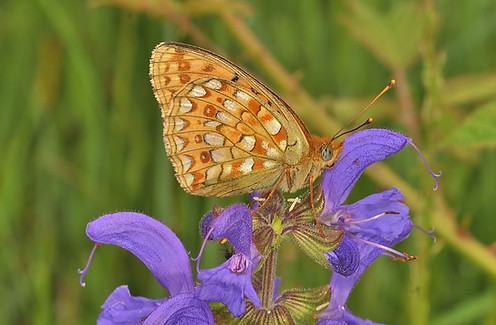
The high brown fritillary (Fabriciana adippe) is a large, brightly colored butterfly native to Europe, known for its striking appearance and significant conservation concerns due to its declining population.
The butterfly was once very common in Hampshire being found in most of the New Forest Inclosures throughout the 19th and early 20th century, and up to the early part of the 1970's. It really declined disasterously after the Second World War, where I assume it could not compete with the stands of Conifer plantations that sprung up in many woods, because of wood shortages.. It was seen in woods all around Chandlers Ford in and around Harewood Forest and on the Isle of Wight at Parkhurst Forest and Firestone Copse. It was also found in other parts of Hampshire like around the escarpments around Petersfield where its last colonies were seen.
The high brown fritillary is not only a beautiful butterfly but also a crucial indicator of the health of its ecosystem. Conservation efforts are essential to ensure its survival and the preservation of the habitats it relies on. By understanding its needs and threats, we can better support initiatives aimed at protecting this remarkable species.
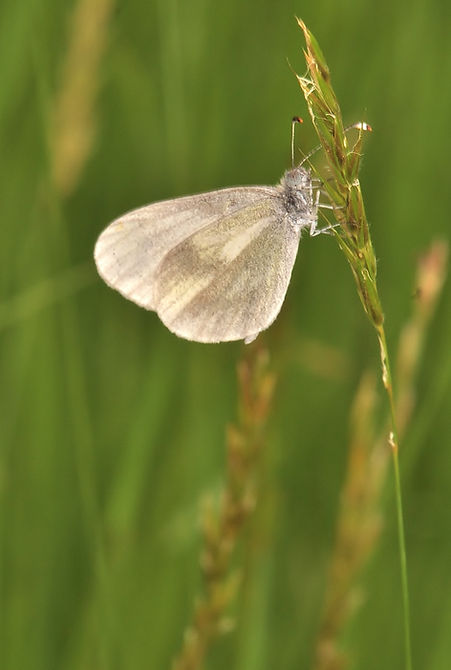
Wood White

Heath Fritillary
Helice form of the Clouded Yellow laying her eggs

Clifden nonpariel

Silver 'Y' Moth
Camberwell Beauty or Morning Cloak
Painted Lady

Hummingbird Hawk Moth

Box Tree Moth